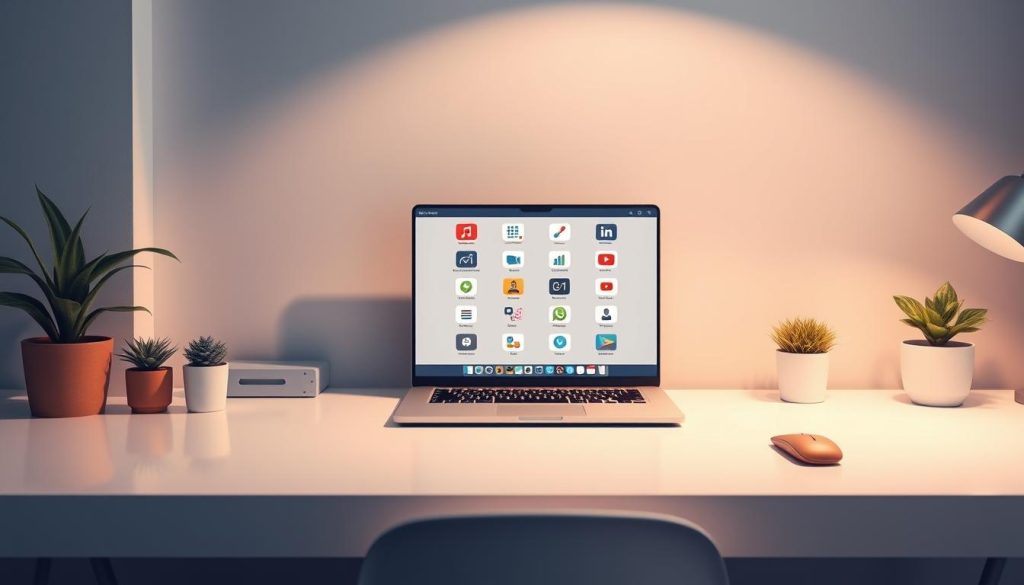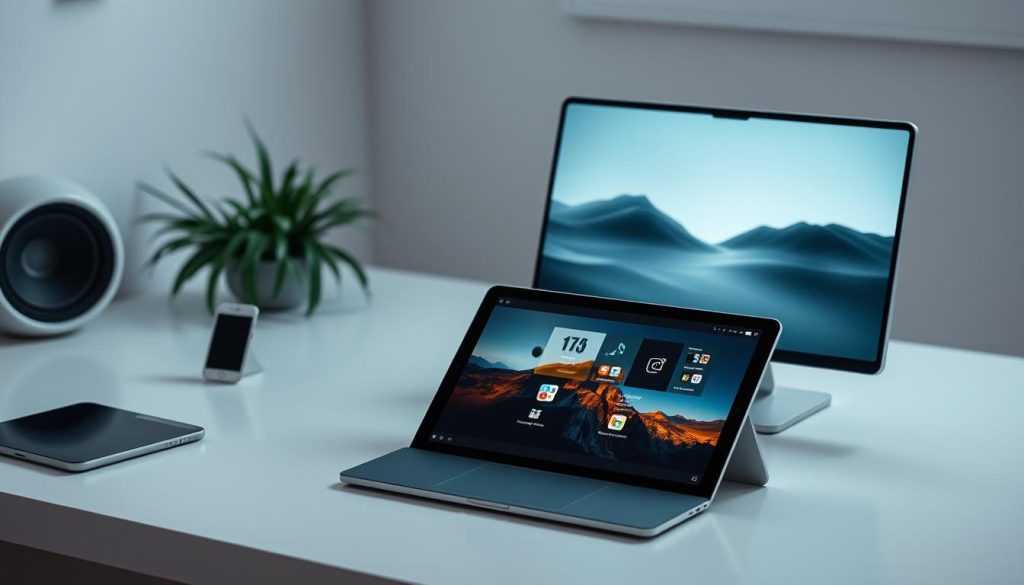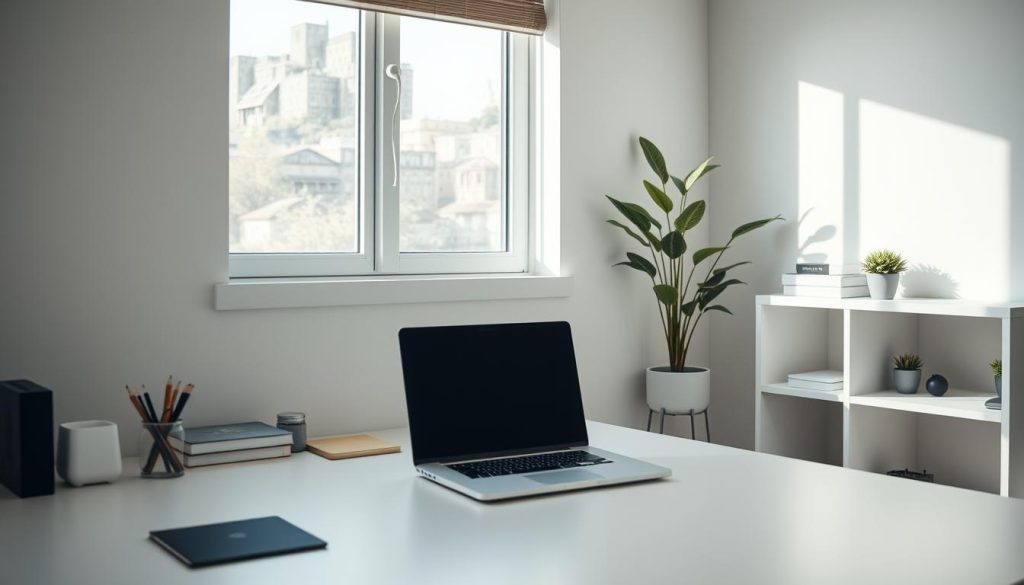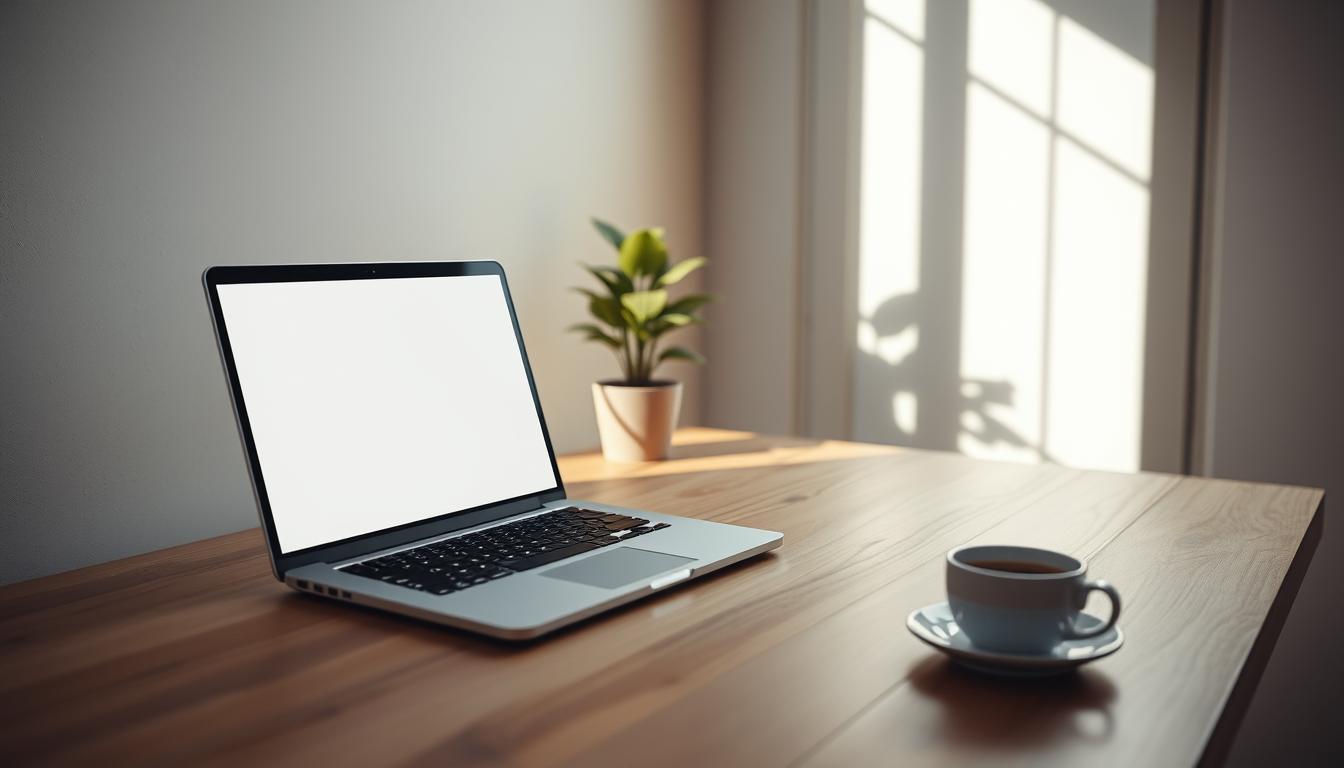I’m on a mission to simplify my digital life. Our world is always connected, making it hard to keep up. Digital minimalism helps us focus on what’s important in our tech lives.
Embracing digital minimalism has improved my tech-life balance. It’s not about giving up tech, but using it wisely. In this article, I’ll share tips on decluttering your digital space and healthier tech habits.
Ready to take control of your digital life? Let’s see how digital minimalism can bring peace in the digital age. It makes technology serve us, not the other way around.
Understanding Digital Minimalism
In today’s world, digital minimalism is a fresh take on using technology. It helps me find balance and joy in my digital life.
Definition and Core Principles
Digital minimalism means using tech on purpose. It’s not about avoiding digital tools. Instead, it’s about using them in ways that match our values and goals. The main ideas include:
- Focusing on what’s truly important
- Clearing out digital junk
- Picking the right digital tools
- Setting limits on tech use
Benefits of Embracing Digital Minimalism
Embracing digital minimalism brings many benefits. I’ve seen my productivity and focus improve, and I feel less stressed. Here are the main advantages:
| Benefit | Description |
|---|---|
| Enhanced Focus | Less digital noise means better focus |
| Improved Relationships | More quality time with family and friends |
| Better Time Management | More time for things I love |
| Reduced Stress | Less digital overwhelm and anxiety |
Digital Minimalism vs. Digital Detox
Digital minimalism and digital detox both aim to cut down on digital clutter. But they differ in approach. Digital detox is a short break from tech, while digital minimalism is a long-term way of living. Here’s how they compare:
Digital minimalism is about building lasting habits. Digital detox is more of a quick reset. By choosing digital minimalism, I’ve found a way to keep a healthy balance with technology.
The Rise of Digital Clutter
I’ve noticed a troubling trend in our digital lives. We’re drowning in a sea of apps, notifications, and endless streams of content. This digital clutter has become a real problem, affecting our productivity and well-being.
The explosion of social media platforms has contributed significantly to this issue. We’re constantly connected, scrolling through feeds, and jumping between apps. This constant connectivity leads to information overload, making it hard to focus on what truly matters.
Tech overwhelm is becoming increasingly common. Our devices are filled with unused apps, unread emails, and forgotten files. This digital mess not only clutters our screens but also our minds. It’s time we recognize the impact of this digital chaos on our mental health and take steps to declutter our digital lives.
| Digital Clutter Source | Impact on Well-being | Decluttering Strategy |
|---|---|---|
| Unused Apps | Wasted Storage, Visual Distraction | Regular App Audits |
| Excessive Notifications | Constant Interruptions, Stress | Customize Notification Settings |
| Unorganized Files | Time Wasted Searching, Frustration | Implement File Organization System |
By addressing these sources of digital clutter, we can reduce tech overwhelm and create a more mindful digital environment. It’s crucial to take control of our digital spaces to improve our overall well-being and productivity in this increasingly connected world.
Assessing Your Digital Footprint
Understanding your digital footprint is key in today’s world. I’ll show you how to assess your online presence. This will help you take control of your digital life.
Auditing Your Devices and Apps
Begin by checking your devices. Make a list of all your gadgets and apps. This audit will show you interesting facts about your digital habits. I was surprised to find over 100 apps on my phone, many unused for months!
Identifying Time-Wasting Tech Habits
Then, track your screen time for a week. Use tools on your devices or download an app. See which apps take up most of your time. You might find habits you didn’t know about. I was shocked to find I spent 3 hours daily on social media!
Recognizing Digital Overwhelm Symptoms
Notice how tech affects your well-being. Signs include feeling anxious without your phone, trouble focusing, or feeling tired after screen time. I experienced headaches and restlessness, clear signs of digital overwhelm.
- Constant urge to check notifications
- Trouble sleeping due to late-night scrolling
- Neglecting real-life relationships for online interactions
By doing this detailed assessment, you’ll learn a lot about your digital life. This knowledge is the first step to a healthier balance in our tech world.
Decluttering Your Digital Space

Decluttering technology is essential for a peaceful digital life. It helps reduce stress and boosts productivity. Let’s look at ways to organize our digital world and set up a minimalist tech setup.
Begin with your devices. Remove unused apps and files to free up space. I organize my apps into folders for easy access. This makes my device clean and efficient.
Then, tackle your email inbox. Unsubscribe from newsletters you don’t read and sort messages with filters. I aim for an “inbox zero” to reduce digital stress.
Cloud storage needs organization too. Delete unnecessary files and organize the rest. I use descriptive file names and tags for easy searching.
Here’s a quick checklist for decluttering your digital space:
- Delete unused apps and files from devices
- Organize remaining apps into folders
- Clean up email inbox and set up filters
- Streamline cloud storage
- Choose essential tools for a minimalist tech setup
The goal of decluttering technology is to simplify your digital life. By following these steps, you’ll have a more organized digital space. This lets you focus on what’s important.
Implementing Intentional Digital Usage
In today’s digital world, being mindful of our tech use is vital. Intentional digital usage can change how we view technology. Let’s look at how to set goals, create boundaries, and make a digital minimalism plan that works for you.
Setting Clear Purposes for Online Activities
To use technology wisely, I first define my online goals. This stops me from aimlessly scrolling and lets me focus on what’s important. Here’s a simple way to sort online activities:
- Productive tasks (work, learning)
- Communication (emails, messaging)
- Entertainment (streaming, gaming)
- Personal growth (reading, meditation apps)
Creating Boundaries for Tech Consumption
Setting limits on tech use is essential for balance. I’ve found these strategies helpful:
- Make tech-free areas in your home
- Set times for checking emails and social media
- Use app blockers during work hours
- Have a digital bedtime
Developing a Digital Minimalism Action Plan
Having a digital minimalism plan keeps me on track with my tech goals. Here’s a simple plan I follow:
| Area | Current Habit | Goal | Action Steps |
|---|---|---|---|
| Social Media | 2 hours daily | 30 minutes daily | Use app timer, unfollow inactive accounts |
| Check hourly | Check twice daily | Turn off notifications, set specific check times | |
| Streaming | 3 hours nightly | 1 hour nightly | Choose shows in advance, set viewing schedule |
By using these strategies, I’ve greatly improved my digital habits and well-being. The secret to successful digital minimalism is being consistent and regularly checking in with yourself.
Curating Your Online Experiences

Creating curated online experiences is crucial for a fulfilling digital life. By choosing what we see and interact with online, we can make our digital world valuable. It no longer drains us.
Starting a selective online presence means cleaning up our social media feeds. We unfollow accounts that don’t match our interests or values. Then, we follow those that share quality content. This keeps us informed and inspired without feeling overwhelmed.
To keep our online experiences curated, we:
- Set specific times for social media use
- Use browser extensions to block distracting websites
- Subscribe to newsletters from trusted sources
- Create custom lists on Twitter for focused content consumption
Choosing long-form content over quick information makes our online experience better. By diving into in-depth articles and thoughtful discussions, we engage with ideas more deeply. This helps us avoid the endless scroll of shallow content.
Remember, curating your online experiences is an ongoing process. It needs regular checks and adjustments. But the reward is a digital life that enriches us, not drains us.
Mindful Tech Habits for Everyday Life
In today’s digital world, it’s key to have mindful tech habits. These habits help us stay balanced and well. By being conscious of our tech use, we can change how we interact with it.
Practicing Conscious Computing
Conscious computing means using tech with purpose. I set goals for my online time to stay focused. I also use apps to track my screen time, helping me understand my habits.
Implementing Digital Wellness Strategies
Digital wellness strategies keep our tech use in check. I have a “tech-free” hour before bed to sleep better. I also keep my phone away during meals to enjoy food and company more. These small steps have greatly improved my well-being.
Balancing Online and Offline Activities
It’s important to balance our online and offline lives. I plan regular outdoor time and meet people face-to-face. This keeps me grounded and sharpens my social skills. I also enjoy hobbies like gardening and painting, which don’t involve screens.
| Mindful Tech Habit | Benefit | Implementation Tip |
|---|---|---|
| Set daily screen time limits | Reduced digital fatigue | Use built-in device settings |
| Practice digital detox days | Improved focus and creativity | Start with one day per month |
| Use mindfulness apps | Enhanced self-awareness | Set reminders for mindful breaks |
Digital Minimalism in the Workplace

Workplace digital minimalism can change our work lives for the better. It helps us work more efficiently and feel less stressed. Let’s look at some ways to bring digital minimalism to our jobs.
Managing emails is key to digital minimalism at work. I only check my inbox at set times each day. This lets me focus on important tasks without distractions.
I also use filters to sort urgent emails. This keeps my inbox tidy and helps me stay on track.
Reducing digital distractions is also important. I turn off notifications for apps I don’t need and use website blockers when I need to concentrate. This has made me more productive and focused.
To use digital tools wisely, I’ve set up a simple digital workspace. Here’s what’s in my minimalist toolkit:
| Tool Category | Purpose | Example |
|---|---|---|
| Project Management | Task organization and team collaboration | Trello |
| Communication | Team messaging and video calls | Slack |
| Document Creation | Writing reports and presentations | Google Docs |
| Time Tracking | Monitoring productivity and billable hours | Toggl |
By using these strategies, my work has improved a lot. I’m more satisfied with my job. Focusing on essential tools and using them wisely has helped me do more with less digital clutter.
Overcoming Challenges in Digital Minimalism
Starting a digital minimalist lifestyle has its own challenges. I’ve learned that facing these challenges is crucial for success. Let’s look at common obstacles and how to beat them.
Dealing with FOMO
Fear of missing out (FOMO) can block your path to digital minimalism. It’s important to manage FOMO to keep your digital life balanced. Here’s how I handle it:
- I focus on meaningful connections over constant updates.
- I set specific times for checking social media.
- I remind myself that not everything online is as important as it seems.
Managing Social Expectations
Social media can feel overwhelming. To manage these expectations, I:
- Tell friends and family about my digital boundaries.
- Offer other ways to stay in touch, like phone calls or meetups.
- Lead by example and inspire others to be more minimalist.
Staying Committed to Your Goals
Staying committed to digital minimalism is tough. To stay on track, I:
- Regularly review my goals and progress.
- Celebrate small wins in reducing digital clutter.
- Seek support from others who share my goals.
| Challenge | Strategy |
|---|---|
| FOMO | Set specific social media check times |
| Social Expectations | Communicate digital boundaries clearly |
| Commitment | Regular goal review and progress tracking |
By tackling these challenges, I’ve made a minimalist digital lifestyle easier and more fulfilling.
Tools and Apps for Digital Minimalism
I’ve found some amazing tools for simplifying my digital life. These apps help me stay focused and cut down on screen time. For instance, Forest lets me plant virtual trees while I work without distractions.
Software like Freedom and RescueTime have really helped me. They block sites that distract me and track my online time. This info helps me make smarter choices about how I use my digital time.
It’s ironic – we use tech to reduce our tech use! But these tools can be great if we use them wisely. I pick apps that support my goals and don’t clutter my life. The goal is to find the right mix of useful tools without feeling overwhelmed.
Remember, digital minimalism isn’t about getting rid of all tech. It’s about using it thoughtfully. These apps help us develop a healthier relationship with our devices. They help us take back our time and focus in the digital world.
